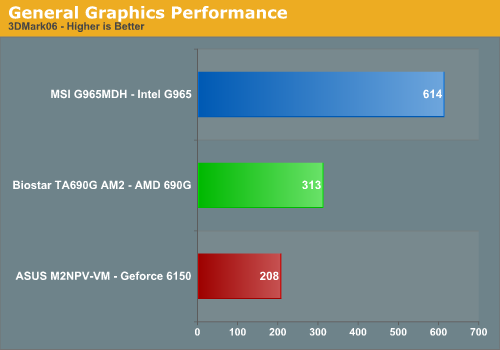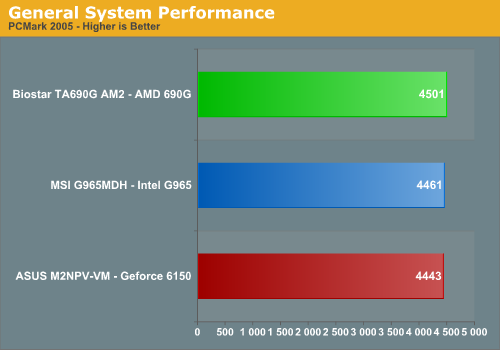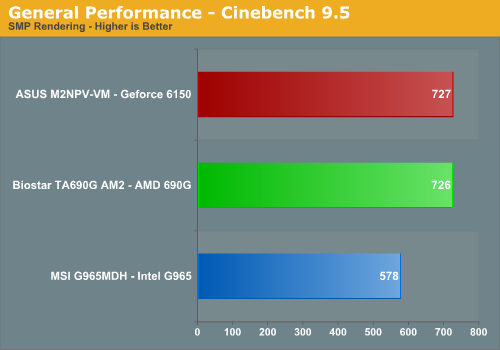Synthetic Graphics Performance
The 3DMark series of benchmarks developed and provided by Futuremark are among the most widely used tools for benchmark reporting and comparisons. Although the benchmarks are very useful for providing apple to apple comparisons across a broad array of GPU and CPU configurations they are not a substitute for actual application and gaming benchmarks. In this sense we consider the 3DMark benchmarks to be purely synthetic in nature but still valuable for providing consistent measurements of performance.

In our first test, the combination of the Intel Core 2 Duo and G965 makes for a great showing against the AM2 offerings. Okay, so we're being a bit sarcastic in that announcement as we consider these results to be anything but great. The Intel platform had no issues running the full 3DMark series but our AMD platforms could not complete the Shader Mark 3.0 tests. However, they exceeded the Intel platform scores in both the SM 2.0 and CPU tests. While the Intel platform passed the SM3.0 tests, this means little in actual game performance where the G965 failed to properly run games with SM3.0 capability.
General System Performance
The PCMark05 benchmark developed and provided by Futuremark was designed for determining overall system performance for the typical home computing user. This tool provides both system and component level benchmarking results utilizing subsets of real world applications or programs. This benchmark is useful for providing comparative results across a broad array of Graphics, CPU, Hard Disk, and Memory configurations along with multithreading results. In this sense we consider the PCMark benchmark to be both synthetic and real world in nature and it provides consistency in our benchmark results.

The margins are closer in the PCMark05 results with the 690G platform showing a minor advantage over the G965 and 6150 platforms. While this benchmark is designed around actual application usage, we will see if these results mirror our application testing.
Rendering Performance
We are using the Cinebench 9.5 benchmark as it tends to heavily stress the CPU subsystem while performing graphics modeling and rendering. Cinebench 9.5 features two different benchmarks with one test utilizing a single core and the second test showcasing the power of multiple cores in rendering the benchmark image. We utilize the standard multiple core benchmark demo and default settings.

The AM2 processors have always enjoyed an advantage in this test and the results continue to show the AM2 platform being dominant in this benchmark with a 26% advantage. The two AM2 platforms basically tie each other indicating CPU throughput is equal on either solution.
The 3DMark series of benchmarks developed and provided by Futuremark are among the most widely used tools for benchmark reporting and comparisons. Although the benchmarks are very useful for providing apple to apple comparisons across a broad array of GPU and CPU configurations they are not a substitute for actual application and gaming benchmarks. In this sense we consider the 3DMark benchmarks to be purely synthetic in nature but still valuable for providing consistent measurements of performance.

In our first test, the combination of the Intel Core 2 Duo and G965 makes for a great showing against the AM2 offerings. Okay, so we're being a bit sarcastic in that announcement as we consider these results to be anything but great. The Intel platform had no issues running the full 3DMark series but our AMD platforms could not complete the Shader Mark 3.0 tests. However, they exceeded the Intel platform scores in both the SM 2.0 and CPU tests. While the Intel platform passed the SM3.0 tests, this means little in actual game performance where the G965 failed to properly run games with SM3.0 capability.
General System Performance
The PCMark05 benchmark developed and provided by Futuremark was designed for determining overall system performance for the typical home computing user. This tool provides both system and component level benchmarking results utilizing subsets of real world applications or programs. This benchmark is useful for providing comparative results across a broad array of Graphics, CPU, Hard Disk, and Memory configurations along with multithreading results. In this sense we consider the PCMark benchmark to be both synthetic and real world in nature and it provides consistency in our benchmark results.

The margins are closer in the PCMark05 results with the 690G platform showing a minor advantage over the G965 and 6150 platforms. While this benchmark is designed around actual application usage, we will see if these results mirror our application testing.
Rendering Performance
We are using the Cinebench 9.5 benchmark as it tends to heavily stress the CPU subsystem while performing graphics modeling and rendering. Cinebench 9.5 features two different benchmarks with one test utilizing a single core and the second test showcasing the power of multiple cores in rendering the benchmark image. We utilize the standard multiple core benchmark demo and default settings.

The AM2 processors have always enjoyed an advantage in this test and the results continue to show the AM2 platform being dominant in this benchmark with a 26% advantage. The two AM2 platforms basically tie each other indicating CPU throughput is equal on either solution.










70 Comments
View All Comments
JarredWalton - Tuesday, March 6, 2007 - link
What's worse is that the G965 scores almost twice as high in 3DMark06... and then falls flat on its face in actual gaming tests. (Well, most of them anyway.)IntelUser2000 - Wednesday, March 14, 2007 - link
I think it might be combination of Vista too. Half Life 2 can score ~20 fps with G965 at the same settings AT tested at, when using Windows XP. I would also like to see how it performs it in XP. It seems G965 suffers more from Vista then other IGP.
chucky2 - Tuesday, March 6, 2007 - link
I think it would be good insurance, given how amazingly late 690G is, to please confirm with AMD that 690G motherboards will definitly support the AM2+ CPU's this late summer/fall.And before people remind me that this is already fact, we have not to my knowledge see AMD themselves confirm this...which for something so seemingly simple to confirm, is getting distrubingly telling.
When AnandTech updates their article and says that they've gone back and confirmed with AMD that all 690G boards being release with support AM2+, or AMD themselves says it, then we'll know for sure. Until then, it's rumor...
Chuck
JarredWalton - Tuesday, March 6, 2007 - link
AMD has not officially stated whether the Agena/Kuma will be drop-in compatible with current AM2 chipsets (or even the AM2 socket). We'd certainly love to know, but we're still waiting along with everyone else.chucky2 - Tuesday, March 6, 2007 - link
Do they have any idea, and have you specifically put the question to them? I'm sure you have contacts at AMD......because from what I can tell, if a discrete graphics card is used, this chipset is looking like when Dr. Evil says, 1 million dollars! ...and then everyone is like, Uh, big deal...
...this thing should have released in Sept. of last year, and then become the defacto AMD chipset, not be released now - as you point out - with MCP68 right around the corner and the G35 coming also.
This chipset really looks to me like a could have been. Good work ATI (and then AMD)!!!
Chuck
Gary Key - Tuesday, March 6, 2007 - link
We asked the question Chuck, have not received an official answer yet. While backwards compatibility has always been discussed as possible by AMD, we are still not convinced with any of the current motherboards. One only has to look at the Conroe launch last year and realize that while the chipsets were compatible, the motherboards were not without an update. We just recently saw this again with Kentsfield. We wish this chipset would have been released last fall also. ;)chucky2 - Tuesday, March 6, 2007 - link
Thanks Guys, that's about all I can ask for.I guess now I've got to really sit down and decide what's the best course of action for my godson and also cousins builds. Their both going to be budget builds, but I don't want to build them an AM2 system and basically have it be End Of Lifed in 3-4 months.
You'd think if AMD wanted to stop the hemmoraging their seeing on the enthusiast side, they'd make a statement about AM2+ compatibility now, rather than wait and just keep loosing more and more. Not that a lot won't go over to the Intel side, but still, tell me 690G and say MCP68 will be the only AM2 chipsets that can take AM2+ CPU's, and now at least I've got a comfortable long term upgrade path.
Leave me in doubt, I mine as well get a 1333FSB Intel board and go to the dark side...
Looking forward to that mATX review...you think it'll be out this time next week, or towards Friday?
Chuck
JarredWalton - Tuesday, March 6, 2007 - link
Honestly, the fact that AMD hasn't come out and said the next gen CPUs will work in AM2 speaks volumes in my book. Perhaps they are just trying to keep things quiet so that a bunch of people won't complain that their particular board won't run the new processors (some 939 boards wouldn't work with X2, after all, and there were some complaints saying AMD "guaranteed backwards compatibility). Hopefully that's all it is, but I am seriously concerned that Kuma and Agena will not work in the vast majority of AM2 boards - that's assuming they'll work in any at all.If AMD doesn't support older boards with the new processors, they are going to need some really impressive performance to keep people from raising Cain. As it stands, if a reasonably fast X2 5200+ or so isn't good enough for your long-term needs, I certainly wouldn't purchase a new AM2 system with the hope of an upgrade until the truth comes out.
Final thought: The Quad FX platform has clearly been stated as being forwards compatible with native quad core Barcelona chips. If AMD is willing to make that commitment, why not make a similar commitment with AM2 and Agena/Kuma?
dmce - Tuesday, March 6, 2007 - link
Are we going to see some details regarding HD (1080P) playback and whether it can do it comfortable or not. I appreciate you made a small comment about it, but this was lifted from the original look at the 690G chipset a few days ago so no real update in this review. Im just puzzled no sites are taking a closer look at this considering its surely one of, if not the whole point of HDMI being there?Im not interested at all in using this for games, i want a 1080p capable machine.
PokerGuy - Wednesday, March 7, 2007 - link
I'm considering a board based on the 690G for my new HTPC, but now I see it won't be able to output 1080P? Yipes... even the lowly 6150 can output at 1080P, correct?Games are not important with regard to this board, but if it can't output at 1080p, what use would it be in a HTPC??
Also, any ETA on when the mATX roundup will be released?